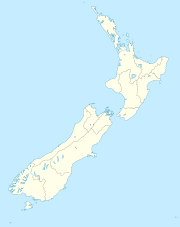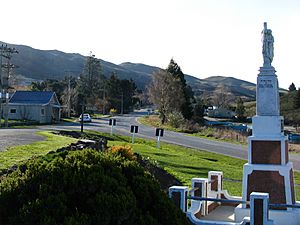Hyde, New Zealand facts for kids
Hyde is a small place in Otago, New Zealand. It is found in an area called the Strath Taieri. Hyde is near the northern part of the Rock and Pillar Range. You can find it on State Highway 87. It's located between the towns of Middlemarch and Ranfurly.
Hyde is most famous for a sad event that happened there. On June 4, 1943, a train crashed near the town. This event is known as the Hyde railway disaster. Twenty-one people lost their lives when an express train went off the tracks. At the time, it was the worst train accident in New Zealand's history. Later, the Tangiwai disaster in 1953 became even worse.
Today, you can visit the site of the Hyde disaster. It's part of the Otago Central Rail Trail. A tall stone monument, called a cairn, stands there. It is 2.5 meters high and remembers those who died.
What Hyde Does: Economy and Tourism
The main way people make a living in Hyde is by helping nearby farms. They provide services and supplies. However, something new has become very important: tourism!
The Otago Central Rail Trail is a popular path for walking and biking. Many people visit Hyde because of it. This has given local farming families new chances. They now offer places for visitors to stay.
The old Otago Central Hotel has been fixed up. It now offers rooms and a cafe. The former Hyde School has become a place for meetings. Even the old Hyde Railway Station is being improved.
Just north of Hyde, there's a special mine. It digs up "white ball" clay. This clay is used to make high-quality pottery. To the southeast, a quarry digs up schist rock. This rock is used for landscaping and building houses.
Hyde's School History
Hyde had some private schools early on, but they didn't last long. One was a night school in 1869. Another was a day school started by Kate Gildea. These schools closed when the teachers moved on.
In 1869, the local church offered its building for a school. The government sent a teacher, Seymour K. Saunders. People in Hyde built a small house for him. This was the start of the official public school. It began with 22 students.
The school committee soon wanted a better building. The old iron church was too hot in summer and too cold in winter. So, in 1879, a new wooden school was built. It had one room and was located on Eton Street (State Highway 87).
The school grew, and by 1893, it had 80 students! The one room was very crowded. So, in 1894, a second classroom was added. It cost £191 to build.
The school never got bigger than two classrooms. But, over the years, new things were added. In 1956, proper bathrooms were built. Before that, students used outdoor toilets.
Besides teaching, the school building was used for community events. Over time, fewer children lived in the area. By the end of 1999, the school had only four students and then closed.
In 2004, the school building was recognized as a historic place. It was given Category 2 status by Heritage New Zealand.
Getting Around: Infrastructure
When the Otago Central Railway line was built, there wasn't enough flat land in Hyde itself. So, the main railway station was built about 2 kilometers (1.2 miles) south of the town. This station had a stationmaster's house, an engine shed, and stockyards. It needed a lot of flat space to load and unload goods.
There was also a smaller stop closer to town. It was called "Hyde Township" flag station. All trains stopped there. This made it easy for passengers to get right into Hyde.
The railway line closed in 1990. The station used to be very busy. Trains carried many things from Hyde. These included scheelite, which is a mineral, and pure white silica sand for making glass. They also carried schist rock for builders and clay for pottery factories.
The only other road besides the main highway is Prendergast Road. It is named after Michael Prendergast. He was one of the first people to live in the gold mining settlements here.



